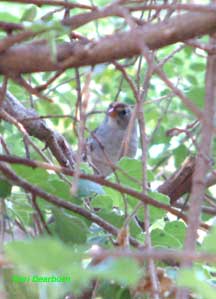
This afternoon I had a distinctly California-autumn moment. As I stood on the path, a Bewick’s wren hopped up from the ground to snatch dried fruit from between the carmel-brown leaves of a native ribes (wild current). The tiny dried currents were few, but they were the food of choice for the diminutive wren. Dried leaves crunched ever so slightly beneath the bird’s light steps.
Finding only a few morsels, the Bewick’s wren then flew up into a feeder dish to check out what I had made available.
 Friday morning, Oct. 6, the white-crowned sparrows returned for the winter. An adult and a juvenile have been sitting high in the lavatera. In the mornings the adult calls loudly.
Friday morning, Oct. 6, the white-crowned sparrows returned for the winter. An adult and a juvenile have been sitting high in the lavatera. In the mornings the adult calls loudly. These seasonal visitors are about a week late. Last year they arrived on September 22 and in 2004 they appeared on September 30. Usually, a small family shows up together. I can’t help but wonder it their delay is related to the appearance of only two birds. Did something happen to the white-crown’s mate? Was there more than one offspring? Will we see the rest of the family appear in the next few days?
It must be time to travel south, because a female black-headed grosbeak stopped in on Saturday. She ate, rested all day in the tree mallow, ate some more, and then continued on her journey. Now I’m keeping an eye out for our other winter residents, the dark-eyed juncos and the hermit thrush.
The desert tortoises have found their favorite winter burrows and are close to settling in for a long sleep.
The male red-shouldered hawk has returned to roost each night in the pine trees. Apparently his fathering duties are over for the year. The Cooper’s hawk however is not happy about the potential competition. This afternoon it tried to chase off the larger hawk.
Autumn is a season of change. Perhaps that is why it is my favorite time of year. Each morning has a crisp edge of possibility.
Early this AM autumn offered a surprise. Coyotes frequent our neighborhood most of the year, but this morning we had a new predator in between our suburban homes. Around 4 AM the dog ran outside to bark. In the middle of the street stood a reasonably-sized bobcat.
It could be a lack of available wild water or the abundance of small prey milling around suburban homes. My hope is that some wild creatures are adapting to survive in a world choked with humans. The wild is adapting to us, can we adapt to them? Can we put aside having to be the dominant creature and find a way to just be good neighbors?
I’m going to plant more wild current and scatter some native grass seed. What are you going to do to be a good neighbor?
No comments:
Post a Comment